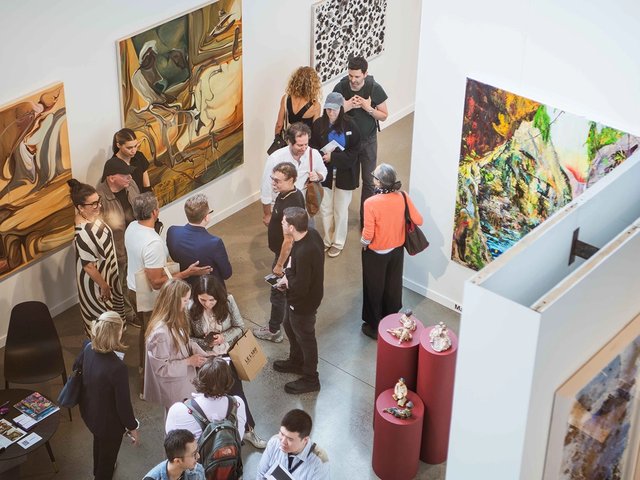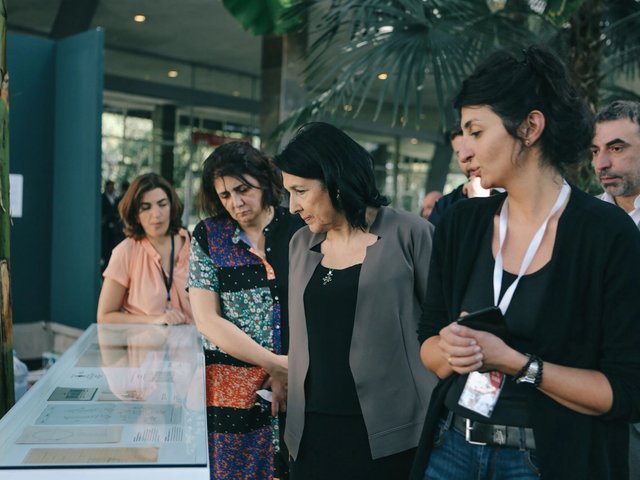Viennacontemporary, previously known as Viennafair, took place from 22 to 25 September in a new location, the lofty, late 19th-century Marx Halle, a glass and cast iron industrial building. The number of galleries was reduced from 130 in 2014 to 99 from 25 countries this year, and the fair’s artistic director Christina Steinbrecher-Pfandt said: “We have now reached the ideal ratio: one third Austrian galleries; one third Eastern European and one third from the rest of the world.” The reduction in the number of participants was also due to the fair’s board of experts, consisting chiefly of prominent Austrian gallerists, who rejected many previous galleries. Instead, 25 new galleries were added, from Paris, London, Cologne, Copenhagen, Warsaw and Moscow.
Viennacontemporary is one of the few overseas fairs where Russian galleries are represented. Moscow’s Regina had a notable stand with the 1995 series of photographs If I Were a German by Boris Mikhailov and Sergei Bratkov (priced at €95,000). Moscow’s Triumph Gallery had a beautiful stand with reliefs by Recycle Group and Alexander Brodsky and paintings by Taisia Korotkova, who employs the old technique of tempera on gesso (priced at around €25,000). The brand new Gallery Triangle brought three artists from Moscow, Valery Chtak, Georgy Ostretsov and Liudmila Konstantinova (Ostretsov’s painting priced at €35,000).
Such prices looked impressive against the generally democratic backdrop of the event; since viennacontemporary specialises in young, modern or scarcely promoted artists from countries lacking a strongly developed art scene, it costs little to become a collector here. For example, pleasing drawings by students of the Viennese University of Applied Arts (the university has a separate stand this year) could be had for a couple of hundred euros.
This does not mean that there were no big names at the fair, which also presented works by Austrian heavyweights, from Valie Export to Hermann Nitsch, as well as international stars, including Marina Abramovic, Andy Warhol, Dennis Oppenheim and Vanessa Beecroft. But their works were often from early in their careers—for instance, it was hard to recognise the scruffy-looking girl in a 1975 photograph as the present-day diva Marina Abramovic. Known for his spectacular video installations on urban façades, Fabrizio Plessi had fun decorating the stand of the Viennese gallery Mario Mauroner with three giant, rusty urinals that made visitors jump at noises that sounded as though emanating from a public lavatory.
A visit to the fair was an adventure that could lead to many curious discoveries, be it works by Paul Neagu, who fled his home city of Bucharest for London in 1970, on a Romanian stand called Ivan, or the modest and sentimental stand of Galerie Window from Tbilisi displaying works by Georgian artists of the perestroika era, artists who were once popular in Moscow. The gallery does not have its own space, said gallerist Irena Popiashvili, the co-rector of the Academy of Arts in Tbilisi. It just has a window in a building on Rustaveli Prospekt, hence the name of the gallery. Another surprise was a wall with a storyboard in pencil of Eisenstein’s movie Battleship Potemkin. The author is the young Bulgarian Nestor Kovachev, now living in Vienna. “I have re-shot Eisenstein’s film with a happy ending,” he told us. This piece is priced at €35,000.
The special focus at this year’s fair was in fact on Bulgaria. “We set the artists the task of creating works that could be hung on a wall, and this, as you know, is not easy,” said Iara Boubnova, who was the curator of the project, representing around 24 artists, together with Vessela Nozharova and supported by various private foundations. But the easel works were eclipsed by a stand-alone installation, Bulgaria Bar by Nedko Solakov. This working bar, enthusiastically used during the private view, had a counter that outlined the silhouette of Bulgaria on a map. “It’s a very symbolic piece—at a crossroads of cultures, Bulgaria plays the role of an understanding barman who listens to other people’s stories,” said Boubnova.
Two sections of the fair served to introduce new artists. In Reflections, with its curated displays, Berlin-based Volker Diehl held a surprising retrospective of Kiev Minimalism, while the commercial heavyweight dealer Thaddaeus Ropac showed Imran Qureshi, with his pieces that look as though painted in blood (€95,000). In Zone 1, 12 galleries made mini-presentations of works by young artists. On the opening day, this was the area where the little red dots went up fastest.
VIPs were treated to museum visits and access to private collections such as the Palais Rasumofsky, where the current owner, Antonis Stachel, shocked guests with an exhibition of giant photographic portraits of refugees from Senegal in the ceremonial halls. “We must think about those who live in poverty today and who need help,” he said. The collectors nodded in agreement.



